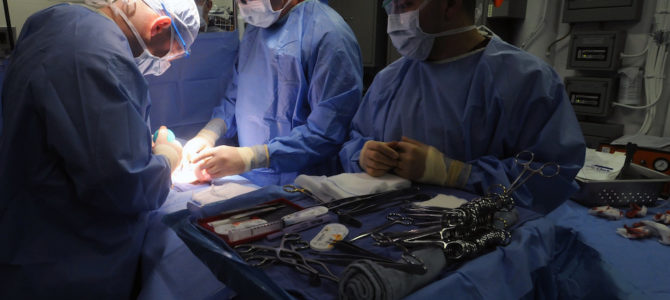
When the lockdowns began last month, we were told that if we didn’t stay home our hospitals would be overwhelmed with coronavirus patients, intensive care wards would be overrun, there wouldn’t be enough ventilators, and some people would probably die in their homes for lack of care. To maintain capacity in the health-care system, we all had to go on lockdown—not just the big cities, but everywhere.
So we stayed home, businesses closed, and tens of millions of Americans lost their jobs. But with the exception of New York City, the overwhelming surge of coronavirus patients never really appeared—at least not in the predicted numbers, which have been off by hundreds of thousands.
During a press conference Wednesday, Florida Gov. Ron DeSantis noted that health experts initially projected 465,000 Floridians would be hospitalized because of coronavirus by April 24. But as of April 22, the number is slightly more than 2,000.
Even in New York, where Gov. Andrew Cuomo said last month he would need 30,000 ventilators, hospitals never came close to needing that many. The projected peak need was about 5,000, and actual usage may have been even lower.
Other overflow measures have also proven unnecessary. On Tuesday, President Trump said the USNS Comfort, the Navy hospital ship that had been deployed to New York to provide emergency care for coronavirus patients, will be leaving the city. The ship had been prepared to treat 500 patients. As of Friday, only 71 beds were occupied. An Army field hospital set up in Seattle’s pro football stadium shut down earlier this month without ever having seen a single patient.
It’s the same story in much of the country. In Texas, where this week Gov. Greg Abbott began gradually loosening lockdown measures, including a prohibition on most medical procedures, hospitals aren’t overwhelmed. In Dallas and Houston, where coronavirus cases are concentrated in the state, makeshift overflow centers that had been under construction might not be used at all.
In Illinois, where hospitals across the state scrambled to stock up on ventilators last month, fewer than half of them have been put to use—and as of Sunday, only 757 of 1,345 ventilators were being used by COVID-19 patients. In Virginia, only about 22 percent of the ventilator supply is being used.
Meanwhile, hospitals and health care systems nationwide have had to furlough or lay off thousands of employees. Why? Because the vast majority of most hospitals’ revenue comes from elective or “non-essential” procedures. We’re not talking about LASIK eye surgery but things like coronary angioplasty and stents, procedures that are necessary but maybe not emergencies—yet. If hospitals can’t perform these procedures because governors have banned them, then they can’t pay their bills, or their employees.
To take just one example, a friend who works in a cardiac intensive care unit (ICU) in rural Virginia called recently and told me about how they had reorganized their entire system around caring for coronavirus patients. They had cancelled most “non-essential” procedures, imposed furloughs and pay cuts, and created a special ICU ward for patients with COVID-19. So far, they have had only one patient. One. The nurses assigned to the COVID-19 ward have very little to do. In the entire area covered by this hospital system, only about 30 people have tested positive for COVID-19.
If Hospitals Can Handle The Load, End The Lockdowns
I’m sure the governors and health officials who ordered these lockdowns meant well. They based their decisions on deeply flawed and woefully inaccurate models, and they should have been less panicky and more skeptical, but they were facing a completely new disease about which, thanks to China, they had almost no reliable information.
However, in hindsight it seems clear that treating the entire country as if it were New York City was a huge mistake that has cost millions of American jobs and destroyed untold amounts of wealth. Now that we know our hospitals aren’t going to be overrun by COVID-19 cases, governors and mayors should immediately reverse course and begin opening their states and communities for business.
Of course, some already are—and in a phased, cautious manner, as they should. But the overarching narrative that we all bought into, that unless we stayed home and “flattened the curve” our hospitals would be inundated, and if your kids got sick there would be no beds available to treat them, has turned out to be false. It hasn’t happened, and it most likely won’t happen, especially now that new evidence is emerging that suggests many more people have already contracted COVID-19 than previously thought, which means the disease might be far less lethal than we feared.
Public officials responsible for the lockdowns will no doubt claim that without these draconian measures, our hospitals surely would have been overwhelmed. And who knows? Maybe they would have. It’s an unfalsifiable assertion.
But at this point we should all be able to agree that the predictions were way off, and not just because they didn’t take into account stay-at-home orders or business closures, because they did. The experts, in this case, were wrong. The best thing governors and mayors can do now is admit as much, and start lifting their lockdown orders so people—including doctors and nurses—can get back to work.









